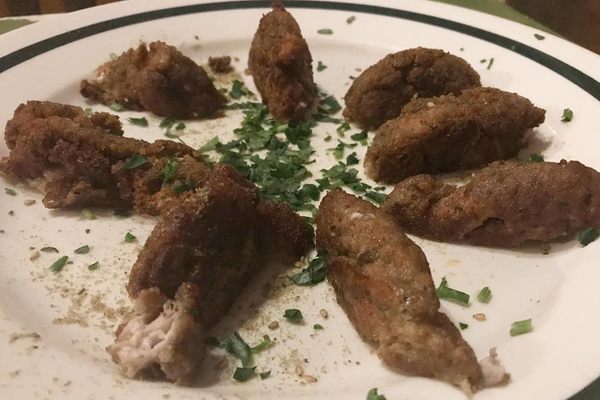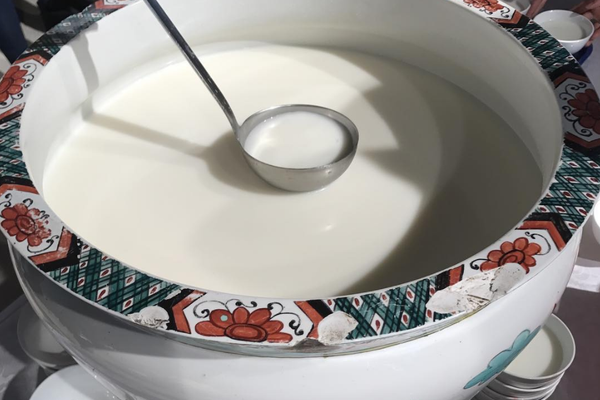Prepared Foods
Fesikh
On Sham el-Nessim, Egyptians celebrate spring by gathering around picnic spreads of fermented fish.
Every year on the day after Coptic Orthodox Easter, Egyptians of all religious backgrounds head outdoors to celebrate Sham el-Nessim. Loved ones congregate around picnic spreads and enjoy the spring air, saturated as it is with the delicate aroma of flowers, along with the sour odor of a fermented fish called fesikh.
To prepare fesikh, uncooked gray mullet is laid out to dry under the sun. Next, cooks place it in a wooden container and submerge it in extremely salty water for several weeks. Usually, the high concentration of salt renders the fish safe to eat. However, when it’s prepared with inadequate salt or with undried fish, botulism and other bacteria can thrive. This was the case in 1991, when 18 people died from consuming the dish.
Despite how unusual or dangerous fesikh may seem to Western European and American palates, people have been preparing and consuming similar dishes, such as ancient Rome’s garum and Southeast Asia’s salty fermented fish sauce, for centuries. Fesikh, garum, and the like are sources of a strong umami flavor. Moreover, they enable people to preserve a valuable food source in temperatures that would normally result in spoilage.
As with many of Egypt’s traditions, both fesikh and Sham el-Nessim owe their existence to Egyptians’ Nile-centric lifestyle. While the festival’s name translates to “smell the breeze” in Arabic, its etymology traces back to the Coptic word shemu. Coptic is the last stage of the ancient Egyptian language and is still used liturgically by the country’s Christian population. Shemu is derived from shomu, the season that ancient Egyptians associated with the Nile’s receding water level, which marked both spring and the harvest.
Just as their ancient ancestors eagerly greeted the harvest, so do contemporary Egyptians. Some variation of Sham el-Nessim has been celebrated since at least 2,700 BC. The consumption of fesikh, now with spring onions and a generous squeeze of lemon, is likely just as ancient, which might explain its persistence in spite of health concerns and even official warnings. Every year since 1991, the Egyptian government cautions citizens about the dangers of consuming fesikh, and every year, the warning goes largely unheeded. Fesikh, like molokhiyya and ful medames, is deeply rooted in the national psyche as something quintessentially and timelessly Egyptian, and is unlikely to be eradicated anytime soon.
Where to Try It
-
Shaheen for Salted Fish and Caviar Website
3 El-Tahrir Square, Cairo, 11562, EgyptThe Shaheen family has been selling fesikh since 1912 and are considered one of the most reliable vendors.
Written By
 Rebecca Byrne
Rebecca Byrne
Sources
- english.ahram.org.eg/NewsContent/1/64/263096/Egypt/Politics-/Egyptians-celebrate-Sham-ElNessim-in-parks-with-pi.aspx
- www.bbc.com/travel/story/20170323-the-deadly-dish-people-love-to-eat
- www.albawaba.com/loop/why-do-egyptians-risk-death-fish-dish-836170
- www.usatoday.com/story/news/world/2015/04/15/globalpost-egypt-dangerous-delicacy/25813253/
- www.britannica.com/place/Egypt/Agriculture-and-fishing
- www.egypttoday.com/Article/4/47334/Sham-El-Nessim-Egypt’s-oldest-celebration
- english.ahram.org.eg/NewsContent/32/97/263116/Folk/Street-Smart/A-very-ancient-Egyptian-Easter-Sham-ElNessim.aspx
- www.huffingtonpost.com/entry/egyptians-celebrate-sham-el-nessim-despite-the-prohibiting_us_58f3f417e4b0156697225085
- education.microsoft.com/Story/SkypeLesson?token=yCTUE
- cairoscene.com/ArtsAndCulture/Sham-El-Nessim-s-Roots-in-Ancient-Egypt
- st-takla.org/books/en/church/synaxarium/10-beona.html Daily Coptic Synaxarium (Coptic Orthodox Calendar)
- The Coptic Christian Heritage: History, Faith and Culture By Lois M. Farag
- www.nationalgeographic.com/archaeology-and-history/magazine/2018/01-02/what-is-garum-rome-fish-sauce/
- journals.sagepub.com/doi/abs/10.1177/146642400512500312
- www.museedelhistoire.ca/cmc/exhibitions/civil/egypt/egctimee.html















